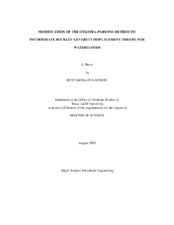| dc.description.abstract | The Dykstra-Parsons model describes layer 1-D oil displacement by water in
multilayered reservoirs. The main assumptions of the model are: piston-like
displacement of oil by water, no crossflow between the layers, all layers are individually
homogeneous, constant total injection rate, and injector-producer pressure drop for all
layers is the same. Main drawbacks of Dykstra-Parsons method are that it does not take
into account Buckley-Leverett displacement and the possibility of different oil-water
relative permeability for each layer.
A new analytical model for layer 1-D oil displacement by water in multilayered reservoir
has been developed that incorporates Buckley-Leverett displacement and different oilwater
relative permeability and water injection rate for each layer (layer injection rate
varying with time). The new model employs an extensive iterative procedure, thus
requiring a computer program.
To verify the new model, calculations were performed for a two-layered reservoir and
the results compared against that of numerical simulation. Cases were run, in which
layer thickness, permeability, oil-water relative permeability and total water injection
rate were varied.
Main results for the cases studied are as follows. First, cumulative oil production up to
20 years based on the new model and simulation are in good agreement. Second, model
water breakthrough times in the layer with the highest permeability-thickness product (kh) are in good agreement with simulation results. However, breakthrough times for the
layer with the lowest kh may differ quite significantly from simulation results. This is
probably due to the assumption in the model that in each layer the pressure gradient is
uniform behind the front, ahead of the front, and throughout the layer after water
breakthrough. Third, the main attractive feature of the new model is the ability to use
different oil-water relative permeability for each layer. However, further research is
recommended to improve calculation of layer water injection rate by a more accurate
method of determining pressure gradients between injector and producer. | en |


